 HOW TO DRINK
HOW TO DRINK  ANCIENT WISDOM FOR MODERN READERS
ANCIENT WISDOM FOR MODERN READERS  How to Drink: A Classical Guide to the Art of Imbibing by Vincent Obsopoeus How to Be a Bad Emperor: An Ancient Guide to Truly Terrible Leaders by Suetonius How to Be a Leader: An Ancient Guide to Wise Leadership by Plutarch How to Think about God: An Ancient Guide for Believers and Nonbelievers by Marcus Tullius Cicero How to Keep Your Cool: An Ancient Guide to Anger Management by Seneca How to Think about War: An Ancient Guide to Foreign Policy by Thucydides How to Be Free: An Ancient Guide to the Stoic Life by Epictetus How to Be a Friend: An Ancient Guide to True Friendship by Marcus Tullius Cicero How to Die: An Ancient Guide to the End of Life by Seneca How to Win an Argument: An Ancient Guide to the Art of Persuasion by Marcus Tullius Cicero How to Grow Old: Ancient Wisdom for the Second Half of Life by Marcus Tullius Cicero How to Run a Country: An Ancient Guide for Modern Leaders by Marcus Tullius Cicero How to Win an Election: An Ancient Guide for Modern Politicians by Quintus Tullius Cicero HOW TO DRINK
How to Drink: A Classical Guide to the Art of Imbibing by Vincent Obsopoeus How to Be a Bad Emperor: An Ancient Guide to Truly Terrible Leaders by Suetonius How to Be a Leader: An Ancient Guide to Wise Leadership by Plutarch How to Think about God: An Ancient Guide for Believers and Nonbelievers by Marcus Tullius Cicero How to Keep Your Cool: An Ancient Guide to Anger Management by Seneca How to Think about War: An Ancient Guide to Foreign Policy by Thucydides How to Be Free: An Ancient Guide to the Stoic Life by Epictetus How to Be a Friend: An Ancient Guide to True Friendship by Marcus Tullius Cicero How to Die: An Ancient Guide to the End of Life by Seneca How to Win an Argument: An Ancient Guide to the Art of Persuasion by Marcus Tullius Cicero How to Grow Old: Ancient Wisdom for the Second Half of Life by Marcus Tullius Cicero How to Run a Country: An Ancient Guide for Modern Leaders by Marcus Tullius Cicero How to Win an Election: An Ancient Guide for Modern Politicians by Quintus Tullius Cicero HOW TO DRINK  A Classical Guide to the Art of Imbibing Vincent Obsopoeus Edited, translated, and introduced
A Classical Guide to the Art of Imbibing Vincent Obsopoeus Edited, translated, and introduced
by Michael Fontaine PRINCETON UNIVERSITY PRESS PRINCETON AND OXFORD Copyright 2020 by Princeton University Press Requests for permission to reproduce material from this work should be sent to Published by Princeton University Press 41 William Street, Princeton, New Jersey 08540 6 Oxford Street, Woodstock, Oxfordshire OX20 1TR press.princeton.edu All Rights Reserved ISBN 9780691192147 ISBN (e-book) 9780691200842 British Library Cataloging-in-Publication Data is available Editorial: Rob Tempio and Matt Rohal Production Editorial: Sara Lerner Text and Jacket Design: Pamela Schnitter Production: Erin Suydam Publicity: Jodi Price and Amy Stewart Jacket Credit: Michelangelo, Bacchus with Pan. Museo del Bargello, Florence, Italy. Photo credit: Pictures Now / Alamy Stock Photo This book has been composed in Stempel Garamond Printed on acid-free paper. Printed in the United States of America 1 3 5 7 9 10 8 6 4 2 For Alyssa, Justine, Ming-Yi, Dan, and Gene
M ec VM et AVERNA pet I st I s I b I q V e FALERNA b I b I st I s CONTENTS ACKNOWLEDGMENTS The life of the mind isnt sustainable over the long haul if it doesnt get rest at regular intervals. (1.21920) This was a fun book, and I owe many people drinks for bringing it to life: Rob Tempio for taking it on, Justine Vanden Heuvel and Ming-Yi Chou for teaching me about wine, the friends who drank it with me, and the team at FLX Fitclub who helped me sweat it all back out. Lucy Plowe painted the beautiful illustration of Greek and Roman wine vessels, Julia Hejduk and Sophia Evans clarified the translation, and Kim Hastings stabilized it.
I thank them all for their generosity. In recent years, George Thomas, who writes under the pen name Quintus Curtius, has quietly set an impressive new standard of translation to live up to. I hope he finds this one worthy, and I thank him for advice and encouragement. I would also like to acknowledge my parents in a special way. Growing up outside New Orleans, I imbibed their NOLAn philosophy, a Mardi Gras view of life that celebrates Comus and curses Momus. Twenty-five years later, the puritanism of wider America still feels alien to me.
For that better sense of balance, I thank them. THE FINGER LAKES AVA Ithaca, New York INTRODUCTION America has a drinking problem. Shots. Chugging. Contests. Frat culture.
Bro culture. Puking. Passing out. Driving home. The traditional name for self-destructive drunkenness is methe in Greek, ebrietas in Latin, and alcoholism in English. The latest name is Alcohol Use Disorder (AUD).
According to the National Institute on Alcohol Abuse and Alcoholism, 16 million people in the United Statesmore than 6 percent of ushave it, and more than 90 percent of them receive no treatment. Temperance failed, Prohibition failed, and here we are. And its not just America. Binge culture is spreading worldwide, with many calling it an American import. But that isnt quite right. People have always gotten drunk and suffered the consequences.
In ancient Rome, you were supposed to water your wine (merum) down to a third of its strength and control yourself. Not everyone did. In enjoying the freedom that men do, remarked Seneca, Women are now enjoying mens problems, too. They stay out late at night no less, they drink no less, they challenge men to wrestling and drinking alcohol (merum), and out of equally upset stomachs, they spit and barf all the wine back up. With a few exceptions, though, binge and bro culture were largely alien to ancient Greece and Rome. The idea that hardcore drinking is a mark of he-man prowess first emerged in Germany in the fifteenth century and spread like a virus in the sixteenth.
Ill say that again: binge and bro cultureso familiar to Americansstarted not in classical Greece or Rome but in Germany five hundred years ago. The crusades were over, the economy was changing, and the knights of the medieval world no longer had any purpose in their lives. They turned to wine to fill the void. Jousting gave way to drinking contests, and with Germanys vineyards four times largerand per capita consumption six times higherthan today, the pressure to indulge was ample: In the 15th century Germans were drinking over 120 litres of wine a head a year. The allowance for a patient in hospital (also for a doctor) was seven litres a day. This is the wine-soaked world Vincent Obsopoeus knew. This is the wine-soaked world Vincent Obsopoeus knew.
When he published The Art of Drinking, Obsopoeuswhose name sounds like Job? So pay us!had been the rector of an elite high school for eight years in Ansbach, a city just south of Wrzburg and Franconias winegrowing region. Inspired by Ovids ancient Art of Love, he lifted his pen to compose a how-to manual to teach the art of drinking responsibly, sustainably, and with discrimination. He wanted young men to clean up their act and get married. Like Ovid, he sought to devise a total system for channeling primal energies that are typically regarded as ungovernable. The result is an antidote to chaos and a timeless classic. In America today, the opposite of sleeping around is not celibacy but monogamy.
In The Art of Drinking, Obsopoeus recommends an analogous attitude toward alcohol. For him, moderation, not abstinence, is the key to lasting sobriety. Readers familiar only with the Alcoholics Anonymous approach to managing addiction will be surprised. Obsopoeus drafted The Art of Drinking while hanging around the learnd monks of Heilsbronn Abbey in Ansbach, and a former wine steward there, one Sebastian Hamaxurgus, composed a poetic blurb for it that Obsopoeus splashed across the title page. In it, the celibacy-bound monk remarks on the poems superficial resemblance to Ovids Art of Love: Naso quidem pulchre leges praescripsit amandi,ut certa insanus curreret arte furor.Pulchrius at multo tradit Vincentius artempotandi, quo sit certus ubique modus.Ut sit amare nefas, tamen est potare voluptas,ex qua virtutem regula iuncta facit. Yes, Ovid did do an impressive job of dictating rules for love, so that a definite art would channel that insane madness. Far more impressively, though, Vincent teaches the art of
Next page
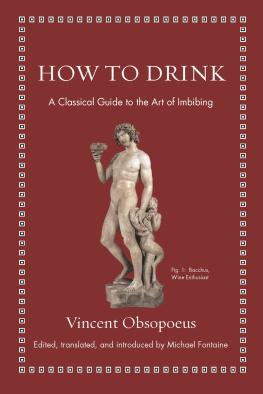

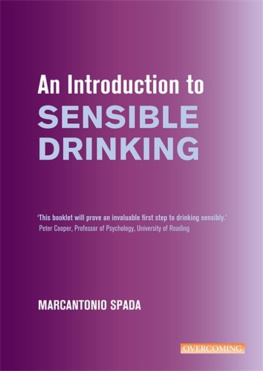

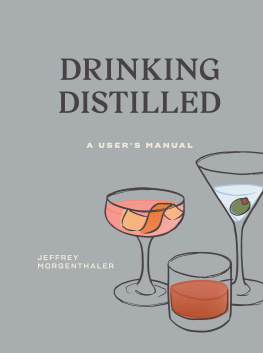
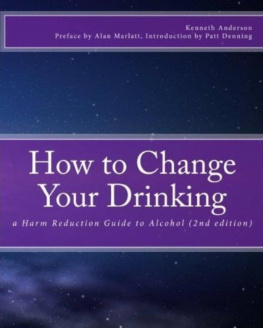

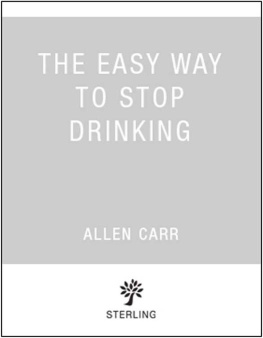

 HOW TO DRINK
HOW TO DRINK  ANCIENT WISDOM FOR MODERN READERS
ANCIENT WISDOM FOR MODERN READERS  A Classical Guide to the Art of Imbibing Vincent Obsopoeus Edited, translated, and introduced
A Classical Guide to the Art of Imbibing Vincent Obsopoeus Edited, translated, and introduced